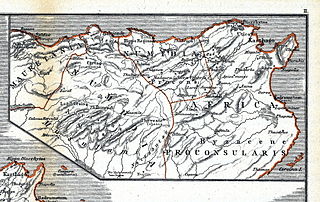Related Research Articles
Patriarchate, Archdiocese, Diocese, Territory, or Exarchate of Jerusalem may refer to:
The Laterculus Veronensis or Verona List is a list of Roman provinces and barbarian peoples from the time of the emperors Diocletian and Constantine I, most likely from AD 314.
Consularis is a Latin adjective indicating something pertaining to the position or rank of consul. In Ancient Rome it was also used as a noun to designate those senators who had held the office of consul or attained consular rank as a special honour. In Late Antiquity, the title became also a gubernatorial rank for provincial governors.

The Catholic Church in Tunisia is part of the worldwide Catholic Church, under the spiritual leadership of the Pope in Rome.

The Catholic Church in Turkey is part of the worldwide Catholic Church, under the spiritual leadership of the Pope and the canonical leadership of the curia in Rome that is submitted to the Pope.

The Catholic Church in Syria is part of the worldwide Catholic Church, under the spiritual leadership of the Pope in Rome.

Catholics in Iraq follow several different rites, but in 2022, most (82%) are members of the Chaldean Catholic Church; about 17% belong to the Syriac Catholic Church, and the remainder are primarily Armenian, Greek and Latin-rite Catholics.
The Notitia provinciarum et civitatum Africae is a Byzantine-era document listing the bishops and sees in the Roman provinces of North Africa, Sardinia and the Balearics. The cause of its preparation was the council of Carthage held on 1 February 484 by the Arian king of the Vandals, Huneric (477–484).

Caesarea in Mauretania was a Roman colony in Roman-Berber North Africa. It was the capital of Mauretania Caesariensis and is now called Cherchell, in modern Algeria. In the present time Caesarea is used as a titular see for Catholic and Eastern Orthodox bishops.
This is a historical list of all bishops of the Catholic Church whose sees were within the present-day boundaries of the United States, with links to the bishops who consecrated them. It includes only members of the United States Conference of Catholic Bishops and their predecessors.

Aquae in Proconsulari is a former Ancient city and bishopric in Roman Africa and present Latin Catholic titular see.
Aquae Albae in Byzacena was an Ancient city and bishopric in Roman Africa and remains a Latin Catholic titular see.
Catholic dioceses in the Holy Land and Cyprus is a multi-rite, international episcopate in Israel and Cyprus.

Numidia was a Roman province on the North African coast, comprising roughly the territory of north-east Algeria.
The gens Tannonia was an obscure plebeian family at ancient Rome. Few members of this gens are mentioned in Roman literature, but many are known from inscriptions.
The Eastern Catholic Churches of the Catholic Church utilize liturgies originating in Eastern Christianity, distinguishing them from the majority of Catholic liturgies which are celebrated according to the Latin liturgical rites of the Latin Church. While some of these sui iuris churches use the same liturgical ritual families as other Eastern Catholic churches and Eastern churches not in full communion with Rome, each church retains the right to institute its own canonical norms, liturgical books, and practices for the ritual celebration of the Eucharist, other sacraments, and canonical hours.
References
- ↑ Annuario Pontificio 2013 (Libreria Editrice Vaticana 2013 ISBN 978-88-209-9070-1)
- ↑ Cf. Glossary of Catholic Terms, p. 7 Archived 2014-08-08 at the Wayback Machine